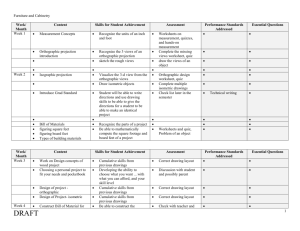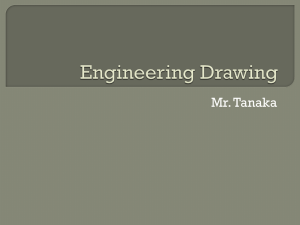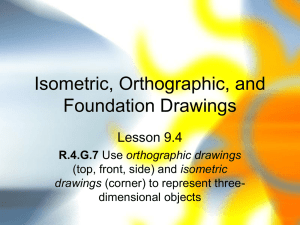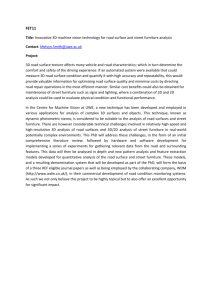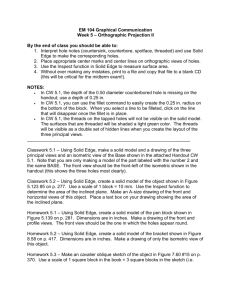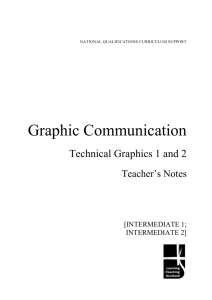Recycled Furniture
advertisement
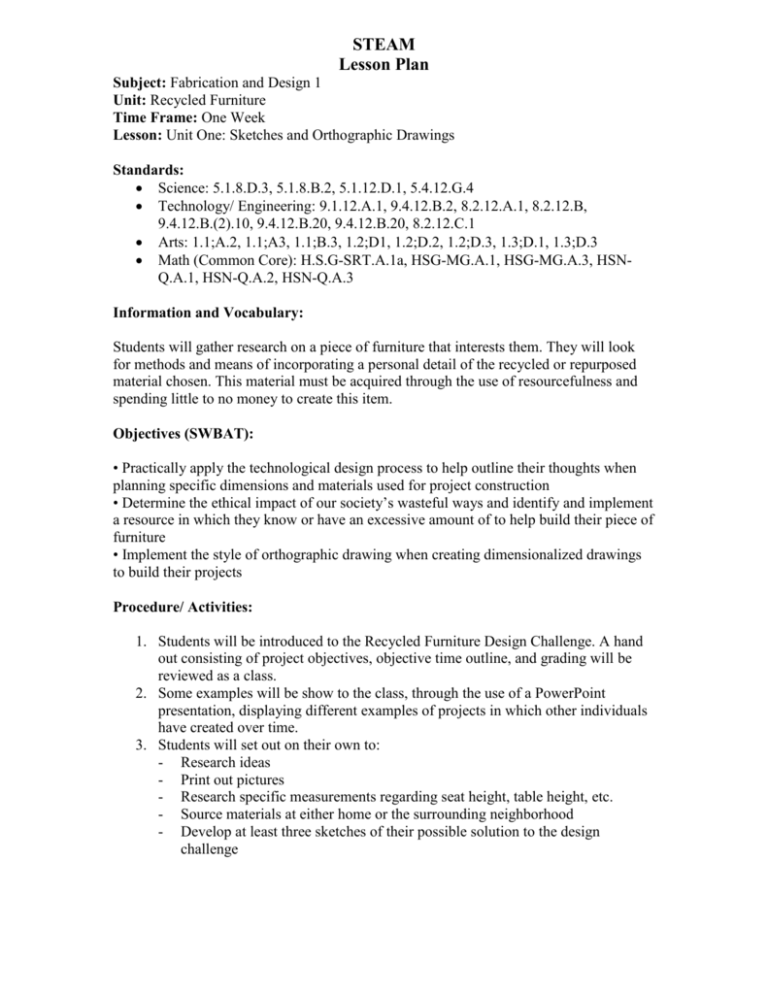
STEAM Lesson Plan Subject: Fabrication and Design 1 Unit: Recycled Furniture Time Frame: One Week Lesson: Unit One: Sketches and Orthographic Drawings Standards: Science: 5.1.8.D.3, 5.1.8.B.2, 5.1.12.D.1, 5.4.12.G.4 Technology/ Engineering: 9.1.12.A.1, 9.4.12.B.2, 8.2.12.A.1, 8.2.12.B, 9.4.12.B.(2).10, 9.4.12.B.20, 9.4.12.B.20, 8.2.12.C.1 Arts: 1.1;A.2, 1.1;A3, 1.1;B.3, 1.2;D1, 1.2;D.2, 1.2;D.3, 1.3;D.1, 1.3;D.3 Math (Common Core): H.S.G-SRT.A.1a, HSG-MG.A.1, HSG-MG.A.3, HSNQ.A.1, HSN-Q.A.2, HSN-Q.A.3 Information and Vocabulary: Students will gather research on a piece of furniture that interests them. They will look for methods and means of incorporating a personal detail of the recycled or repurposed material chosen. This material must be acquired through the use of resourcefulness and spending little to no money to create this item. Objectives (SWBAT): • Practically apply the technological design process to help outline their thoughts when planning specific dimensions and materials used for project construction • Determine the ethical impact of our society’s wasteful ways and identify and implement a resource in which they know or have an excessive amount of to help build their piece of furniture • Implement the style of orthographic drawing when creating dimensionalized drawings to build their projects Procedure/ Activities: 1. Students will be introduced to the Recycled Furniture Design Challenge. A hand out consisting of project objectives, objective time outline, and grading will be reviewed as a class. 2. Some examples will be show to the class, through the use of a PowerPoint presentation, displaying different examples of projects in which other individuals have created over time. 3. Students will set out on their own to: - Research ideas - Print out pictures - Research specific measurements regarding seat height, table height, etc. - Source materials at either home or the surrounding neighborhood - Develop at least three sketches of their possible solution to the design challenge Homework: N/A Assessment/Rubric: 1. Students will submit their sketches with a chosen idea by the end of the week 2. Students will outline their findings for this project through the use of the technological design process STEAM Lesson Plan Subject: Fabrication and Design 1 Unit: Recycled Furniture Time Frame: Two Weeks Lesson: Unit 2: Recycled Furniture - Orthographic Drawing and Model Development Standards: Science: 5.1.8.D.3, 5.1.8.B.2, 5.1.12.D.1, 5.4.12.G.4 Technology/ Engineering: 9.1.12.A.1, 9.4.12.B.2, 8.2.12.A.1, 8.2.12.B, 9.4.12.B.(2).10, 9.4.12.B.20, 8.2.12.C.1 Arts: 1.1;A.2, 1.1;A3, 1.1;B.3, 1.2;D1, 1.2;D.2, 1.2;D.3, 1.3;D.1, 1.3;D.3 Math (Common Core): H.S.G-SRT.A.1a, HSG-MG.A.1, HSG-MG.A.3, HSNQ.A.1, HSN-Q.A.2, HSN-Q.A.3 Information and Vocabulary: Once students have selected their best solution to the design challenge, they will continue to utilize the eight steps of the technological design cycle to help keep track of the evolution of their project. Students will utilize their drawing skills by creating an orthographic drawing that displays specific information to help build their project. Once they have accomplished their drawing, a model of their project must be created. The model will consist of easy to work with materials such as cardboard, paper, hot glue, and other easily source able items that can be morphed into a non-scaled model. Objective (SWBAT): • Practically apply the technological design process to help outline their thoughts when planning specific dimensions and materials used for project construction • Determine the ethical impact of our society’s wasteful ways and identify and implement a resource in which they know or have an excessive amount of to help build their piece of furniture • Implement the style of orthographic drawing when creating dimensionalized drawings to build their projects • Identify what step of the technological design process helped them through their activity in today’s class • Understand the importance of modeling an item prior to its actual construction, so problems can be identified and corrected Procedure: 1. Students will be allotted time to: Sketch their solutions Select the best possible solution 2. Once the best possible solution has been chosen, a comprehensive orthographic drawing must be utilized to help outline specific design and dimensional parameters for the project that at are limited to the following: Height Width Depth Diameters, Radius, and Geometric Angles 3. Drawings will be accomplished with the following criteria: Sketches will accomplished on regular 8.5x11 white paper The orthographic drawing will be accomplished on a 11x17 piece of graph paper - A drafters triangle or ruler must be utilized to accomplish straight and square lines - All drawings must be done in pencil 4. Upon completion of their sketches and orthographic drawing, students will begin their model. This will not be to scale and will be constructed from easy to work with materials such as cardboard, paper, tape, hot glue, and other easily source able items that are easily modified and molded. Model must meet the following criteria: - Be able to fit inside of an invisible 12”x12”x12” box so it can be easily constructed, stored, and conserve materials - Not be made to scale - Use only easy to work with materials (outlined above) Activities: Sketching Orthographic drawing creation Modeling Homework: N/A Assessment/Rubric: Students will be assessed on the following: Sketches Orthographic drawing accuracy and completion An effectively created and communicated model STEAM Lesson Plan Subject: Fabrication and Design 1 Unit: Recycled Furniture Time Frame: 4 Weeks Lesson: Unit 3: Recycled Furniture – Project Build Time Standards: Science: 5.1.8.D.3, 5.1.8.B.2, 5.1.12.D.1, 5.4.12.G.4 Technology/ Engineering: 9.1.12.A.1, 9.4.12.B.2, 8.2.12.A.1, 8.2.12.B, 9.4.12.B.(2).10, 9.4.12.B.20, 8.2.12.C.1 Arts: 1.1;A.2, 1.1;A.3, 1.2;D1, 1.2;D2, 1.2;D3 Math (Common Core): H.S.G-C.A.1, H.S.G-C.A.3, H.S.G-C.A.4, H.S.GSRT.A.1a, HSG-MG.A.1, HSG-MG.A.3, HSN-Q.A.1, HSN-Q.A.2, HSN-Q.A.3, Information and Vocabulary: Upon completion of their sketches, orthographic drawings, and models, students will begin the construction of their actual recycled furniture item. Students needed to source a material in which they wanted to work with based on all of the following criteria: easy to source, can be processed within the classroom in a safe and effective manner, little to no cost, lastly it represents something about them. Students will utilize prior knowledge about: materials, hardware, and construction techniques all learned from other projects. Objective (SWBAT): • Practically apply the technological design process to help document the construction of their project with thorough detail • Determine the ethical impact of our society’s wasteful ways and identify and implement a resource in which they know or have an excessive amount of to help build their piece of furniture • Implement the use of orthographic drawings as a reference for important dimensions, construction steps, and points of fastening • Understand the importance of modeling an item prior to its actual construction, so problems can be identified and corrected Procedure: 1. Students will begin processing materials for their furniture project. Students need to take the following items into consideration prior to processing their working media: - Remove all old hardware prior to joining, surface planing, or cutting on any of the saws in the room - Utilize an appropriate storage area for your project (ex. closet, store room, open corners of the classroom for larger objects) - Measure twice cut once, especially when working with a unique piece of material that cannot be replicated or resourced again - Dry fit and test all pieces prior to final assembly - Reference their plans and model to help avoid any major problems during the prototype construction Activities: Cutting Gluing Nailing Screwing Clamping Machining Layout Work Measurement Homework: N/A Assessment/Rubric: Students will be assessed on the following: Project Grading Rubric - Fit and Finish - Attention to detail - Operation of item (if applicable) - Creative use of materials
